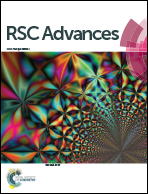Thermal, mechanical and antibacterial properties of cyclophosphazene incorporated benzoxazine blended bismaleimide composites
Abstract
Cyclophosphazene (Cp) incorporated benzoxazine (Bz) and bismaleimide (Bmi) blended (Cp–Bz–Bmi) composites were obtained through ring-opening polymerization with benzoxazine and bismaleimide polymerized via Michael addition with a phosphazene group and a Diels–Alder reaction with a polybenzoxazine group. The cyclophosphazene material was chosen as a filler to improve the thermal, mechanical, electrical resistance and antibacterial properties of Bz–Bmi composites. The results show that the addition of phosphazene can largely enhance the mechanical properties due to the strong chemical interaction between the Bz–Bmi and Cp, which was confirmed by Fourier transform infrared (FT-IR) spectroscopy. The fracture surfaces of the composites were determined by scanning electron microscopy (SEM) and X-ray diffraction (XRD) analysis. The mechanical, thermogravimetric analysis (TGA) and differential scanning calorimetry (DSC) results show that with the increasing percentage of Cp (5, 10 and 15%) in the Bz–Bmi composites, they exhibit better thermal resistance and their corresponding char yield was improved. Broadband dielectric spectroscopy (BDS) studies proved that the Cp–Bz–Bmi composites can be used as electrically resistive materials. The antibacterial properties of the Cp incorporated Bz–Bmi composites also improved due to cyclophosphazene being a bioactive material. Hence, Cp–Bz–Bmi composites are potent materials for marine coating, aerospace and microelectronic applications.


 Please wait while we load your content...
Please wait while we load your content...